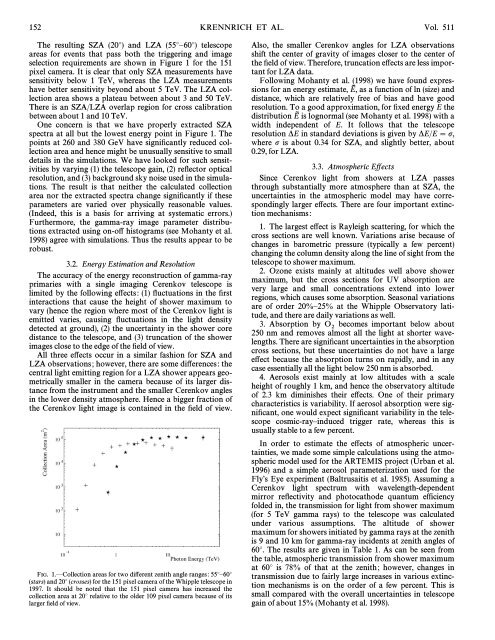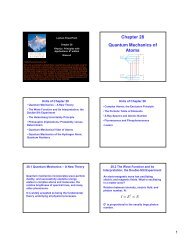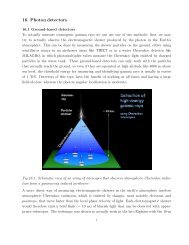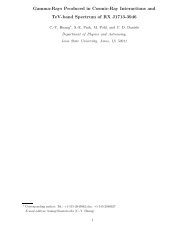Measurement of the Multi-TeV Gamma-Ray Flare Spectra of ...
Measurement of the Multi-TeV Gamma-Ray Flare Spectra of ...
Measurement of the Multi-TeV Gamma-Ray Flare Spectra of ...
You also want an ePaper? Increase the reach of your titles
YUMPU automatically turns print PDFs into web optimized ePapers that Google loves.
152 KRENNRICH ET AL. Vol. 511<br />
The resulting SZA (20¡) and LZA (55¡È60¡) telescope<br />
areas for events that pass both <strong>the</strong> triggering and image<br />
selection requirements are shown in Figure 1 for <strong>the</strong> 151<br />
pixel camera. It is clear that only SZA measurements have<br />
sensitivity below 1 <strong>TeV</strong>, whereas <strong>the</strong> LZA measurements<br />
have better sensitivity beyond about 5 <strong>TeV</strong>. The LZA collection<br />
area shows a plateau between about 3 and 50 <strong>TeV</strong>.<br />
There is an SZA/LZA overlap region for cross calibration<br />
between about 1 and 10 <strong>TeV</strong>.<br />
One concern is that we have properly extracted SZA<br />
spectra at all but <strong>the</strong> lowest energy point in Figure 1. The<br />
points at 260 and 380 GeV have signiÐcantly reduced collection<br />
area and hence might be unusually sensitive to small<br />
details in <strong>the</strong> simulations. We have looked for such sensitivities<br />
by varying (1) <strong>the</strong> telescope gain, (2) reÑector optical<br />
resolution, and (3) background sky noise used in <strong>the</strong> simulations.<br />
The result is that nei<strong>the</strong>r <strong>the</strong> calculated collection<br />
area nor <strong>the</strong> extracted spectra change signiÐcantly if <strong>the</strong>se<br />
parameters are varied over physically reasonable values.<br />
(Indeed, this is a basis for arriving at systematic errors.)<br />
Fur<strong>the</strong>rmore, <strong>the</strong> gamma-ray image parameter distributions<br />
extracted using on-o† histograms (see Mohanty et al.<br />
1998) agree with simulations. Thus <strong>the</strong> results appear to be<br />
robust.<br />
3.2. Energy Estimation and Resolution<br />
The accuracy <strong>of</strong> <strong>the</strong> energy reconstruction <strong>of</strong> gamma-ray<br />
primaries with a single imaging Cerenkov telescope is<br />
limited by <strong>the</strong> following e†ects: (1) Ñuctuations in <strong>the</strong> Ðrst<br />
interactions that cause <strong>the</strong> height <strong>of</strong> shower maximum to<br />
vary (hence <strong>the</strong> region where most <strong>of</strong> <strong>the</strong> Cerenkov light is<br />
emitted varies, causing Ñuctuations in <strong>the</strong> light density<br />
detected at ground), (2) <strong>the</strong> uncertainty in <strong>the</strong> shower core<br />
distance to <strong>the</strong> telescope, and (3) truncation <strong>of</strong> <strong>the</strong> shower<br />
images close to <strong>the</strong> edge <strong>of</strong> <strong>the</strong> Ðeld <strong>of</strong> view.<br />
All three e†ects occur in a similar fashion for SZA and<br />
LZA observations; however, <strong>the</strong>re are some di†erences: <strong>the</strong><br />
central light emitting region for a LZA shower appears geometrically<br />
smaller in <strong>the</strong> camera because <strong>of</strong> its larger distance<br />
from <strong>the</strong> instrument and <strong>the</strong> smaller Cerenkov angles<br />
in <strong>the</strong> lower density atmosphere. Hence a bigger fraction <strong>of</strong><br />
<strong>the</strong> Cerenkov light image is contained in <strong>the</strong> Ðeld <strong>of</strong> view.<br />
FIG. 1.ÈCollection areas for two di†erent zenith angle ranges: 55¡È60¡<br />
(stars) and 20¡ (crosses) for <strong>the</strong> 151 pixel camera <strong>of</strong> <strong>the</strong> Whipple telescope in<br />
1997. It should be noted that <strong>the</strong> 151 pixel camera has increased <strong>the</strong><br />
collection area at 20¡ relative to <strong>the</strong> older 109 pixel camera because <strong>of</strong> its<br />
larger Ðeld <strong>of</strong> view.<br />
Also, <strong>the</strong> smaller Cerenkov angles for LZA observations<br />
shift <strong>the</strong> center <strong>of</strong> gravity <strong>of</strong> images closer to <strong>the</strong> center <strong>of</strong><br />
<strong>the</strong> Ðeld <strong>of</strong> view. Therefore, truncation e†ects are less important<br />
for LZA data.<br />
Following Mohanty et al. (1998) we have found expressions<br />
for an energy estimate, E3 , as a function <strong>of</strong> ln (size) and<br />
distance, which are relatively free <strong>of</strong> bias and have good<br />
resolution. To a good approximation, for Ðxed energy E <strong>the</strong><br />
distribution E3 is lognormal (see Mohanty et al. 1998) with a<br />
width independent <strong>of</strong> E. It follows that <strong>the</strong> telescope<br />
resolution *E in standard deviations is given by *E/E \ p,<br />
where p is about 0.34 for SZA, and slightly better, about<br />
0.29, for LZA.<br />
3.3. Atmospheric E†ects<br />
Since Cerenkov light from showers at LZA passes<br />
through substantially more atmosphere than at SZA, <strong>the</strong><br />
uncertainties in <strong>the</strong> atmospheric model may have correspondingly<br />
larger e†ects. There are four important extinction<br />
mechanisms:<br />
1. The largest e†ect is <strong>Ray</strong>leigh scattering, for which <strong>the</strong><br />
cross sections are well known. Variations arise because <strong>of</strong><br />
changes in barometric pressure (typically a few percent)<br />
changing <strong>the</strong> column density along <strong>the</strong> line <strong>of</strong> sight from <strong>the</strong><br />
telescope to shower maximum.<br />
2. Ozone exists mainly at altitudes well above shower<br />
maximum, but <strong>the</strong> cross sections for UV absorption are<br />
very large and small concentrations extend into lower<br />
regions, which causes some absorption. Seasonal variations<br />
are <strong>of</strong> order 20%È25% at <strong>the</strong> Whipple Observatory latitude,<br />
and <strong>the</strong>re are daily variations as well.<br />
3. Absorption by O becomes important below about<br />
2<br />
250 nm and removes almost all <strong>the</strong> light at shorter wavelengths.<br />
There are signiÐcant uncertainties in <strong>the</strong> absorption<br />
cross sections, but <strong>the</strong>se uncertainties do not have a large<br />
e†ect because <strong>the</strong> absorption turns on rapidly, and in any<br />
case essentially all <strong>the</strong> light below 250 nm is absorbed.<br />
4. Aerosols exist mainly at low altitudes with a scale<br />
height <strong>of</strong> roughly 1 km, and hence <strong>the</strong> observatory altitude<br />
<strong>of</strong> 2.3 km diminishes <strong>the</strong>ir e†ects. One <strong>of</strong> <strong>the</strong>ir primary<br />
characteristics is variability. If aerosol absorption were signiÐcant,<br />
one would expect signiÐcant variability in <strong>the</strong> telescope<br />
cosmic-rayÈinduced trigger rate, whereas this is<br />
usually stable to a few percent.<br />
In order to estimate <strong>the</strong> e†ects <strong>of</strong> atmospheric uncertainties,<br />
we made some simple calculations using <strong>the</strong> atmospheric<br />
model used for <strong>the</strong> ARTEMIS project (Urban et al.<br />
1996) and a simple aerosol parameterization used for <strong>the</strong><br />
FlyÏs Eye experiment (Baltrusaitis et al. 1985). Assuming a<br />
Cerenkov light spectrum with wavelength-dependent<br />
mirror reÑectivity and photocathode quantum efficiency<br />
folded in, <strong>the</strong> transmission for light from shower maximum<br />
(for 5 <strong>TeV</strong> gamma rays) to <strong>the</strong> telescope was calculated<br />
under various assumptions. The altitude <strong>of</strong> shower<br />
maximum for showers initiated by gamma rays at <strong>the</strong> zenith<br />
is 9 and 10 km for gamma-ray incidents at zenith angles <strong>of</strong><br />
60¡. The results are given in Table 1. As can be seen from<br />
<strong>the</strong> table, atmospheric transmission from shower maximum<br />
at 60¡ is 78% <strong>of</strong> that at <strong>the</strong> zenith; however, changes in<br />
transmission due to fairly large increases in various extinction<br />
mechanisms is on <strong>the</strong> order <strong>of</strong> a few percent. This is<br />
small compared with <strong>the</strong> overall uncertainties in telescope<br />
gain <strong>of</strong> about 15% (Mohanty et al. 1998).







